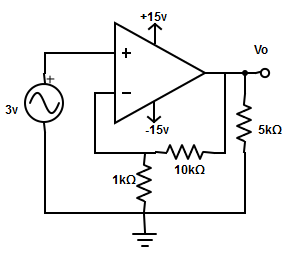11. How is the difference voltage calculated in a closed-loop non-inverting amplifier?
A. Vid= Vo – Vf
B. Vid= Vin – Vf
C. Vid= Vo – Vin
D. Vid= Vf – Vin
12. Why the feedback circuit is said to be negative for voltage series feedback amplifier?
A. Feedback voltage is 180o out of phase with respect to an input voltage
B. Input voltage is 180o out of phase with respect to a feedback voltage
C. Feedback voltage is in the same phase with respect to an input voltage
D. Input voltage is in the same phase with respect to a feedback voltage
13. Determine the closed-loop voltage gain from the given circuit. (Where gain of op-amp= 105).

A. 1090.9
B. 9821.43
C. 9166.66
D. 10000
14. Express closed-loop voltage gain (AF) in terms of open-loop gain (A. and feedback circuit gain (B.?
A. AF = A/AB
B. AF = 1+ (A/AB.
C. AF = A/(1+AB.
D. AF = AB/(1+A.
15. Which factor determines the gain of the voltage series feedback amplifier?
A. Open loop voltage gain
B. Feedback voltage
C. Ratio of two resistors
D. Gain of the feedback circuit
16. For the feedback circuit of the voltage series feedback amplifier, find the feedback voltage for the specifications: R1=1kΩ, RF = 10kΩ, and Vo= 25v.
A. 12.5v
B. 22v
C. 0.9v
D. 2.3v
17. What must be the value of external components used in the voltage series feedback amplifier?
A. Less than 1MΩ
B. Less than 10MΩ
C. Less than 100MΩ
D. Less than 0.1MΩ
18. Define the input resistance with feedback for the voltage series feedback amplifier?
A. RIF = (1-AB.
B. RIF = (AB-1)
C. RIF = (1+AB.
D. None of the mentioned
19. When the non-inverting input terminal of an op-amp is equal to that of the inverting input terminal (ideally)
A. a–>∞
B. Vid ≅ 0
C. AF = 1+( RF / R1)
D. All of the mentioned
20. Find the input and output resistance for the circuit shown.
Specification for 741 op-amp : A=400000 ; Ri = 33MΩ; Ro = 60Ω;
RF = 11kΩ; R1 = 2kΩ; Supply voltage = ± 15v; Maximum output voltage swing = ± 13v.
A. RIF = 66MΩ, ROF = 30Ω
B. RIF = 30MΩ, ROF = 6kΩ
C. RIF = 15kΩ, ROF = 50MΩ
D. None of the mentioned
21. The output resistance of the op-amp with feedback is
A. Same as that of the output resistance without feedback
B. Greater than that of the output resistance without feedback
C. Smaller than that of the output resistance without feedback
D. None of the mentioned
22. Find the output current in the voltage series feedback amplifier.
A. io ={ [Vo+(A*Vid)]/Ro}
B. io ={ [Vo-(A*Vid)]/Ro}
C. io =(Vo/Ro)*A
D. io =[A*(Vo-Vid)]/Ro
23. Find the unity-gain bandwidth for the voltage series feedback amplifier?
A. UBG = Afo
B. UBG = AfF
C. UBG = Afo fF
D. UBG = AFfo
